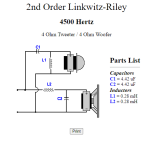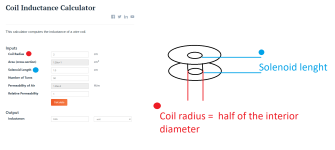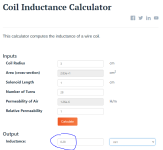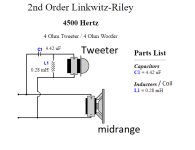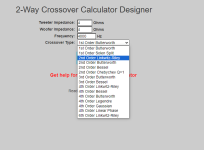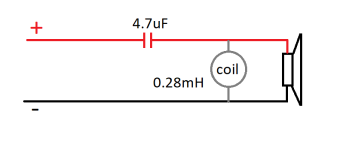Hi guys
I bought a car audio system from abroad. But I have a problem. I need to connect the midrange and tweeter in parallel. I use the crossover mode on the amplifier with the hpf option. This option can cut frequencies in the range of 32-2000 Hz. (I will add photos)
The problem is that I use this setting at the extreme end (2000hz) to avoid damaging the tweeter, which causes the sounds to sound very high-pitched. Can I reduce this frequency setting if I connect a capacitor in series with the tweeter?
I have a 3.35uF capacitor.
midrange; 4 ohm 95-10khz tweeter; 4 ohm 2khz-20khz, fs 2000 , dc resistance 3.2 ohm

I bought a car audio system from abroad. But I have a problem. I need to connect the midrange and tweeter in parallel. I use the crossover mode on the amplifier with the hpf option. This option can cut frequencies in the range of 32-2000 Hz. (I will add photos)
The problem is that I use this setting at the extreme end (2000hz) to avoid damaging the tweeter, which causes the sounds to sound very high-pitched. Can I reduce this frequency setting if I connect a capacitor in series with the tweeter?
I have a 3.35uF capacitor.
midrange; 4 ohm 95-10khz tweeter; 4 ohm 2khz-20khz, fs 2000 , dc resistance 3.2 ohm
Thank you @Perry Babin . Which capacitor do you recommend? I think the one I have filters out frequencies 12khz and below
Hi, a 10uF cap would be good for around 4Khz high pass.
But if you want your tweeters to last longer and be safe , I would build a 2 order filter, at least just for the tweeter. it's easy to built.
Wire you can buy or get from transformers, other crossovers, etc.
anything at least 0.4mm thickness is ok for the tweeter. " thicker wire is recommended 1mm or so " ( you can use two wires in parallel if it's too thin ).
Online Calculator for the coil:
https://www.allaboutcircuits.com/tools/coil-inductance-calculator/
Coil can be made out of styrofoam, cardboard, Fishing line :

Wood, etc.
Value of inductor can be calculated in the online calculator , value depends on the size of the coil and how much wire is used.
---- It is not the " perfect way " of building crossovers, since our speakers don't have 4ohm all the time, it has impedance - that 4ohm changes with frequency, so it might have 4 ohm at 5khz and 6 ohm at 10khz, So if our crossover is calculated at 4ohm for 4khz cut, it will change it's cut frequency a bit. But for most people this is " good enough " , I have built something like this with good results. Not many speakers have " better " crossovers than this anyway.
But if you want your tweeters to last longer and be safe , I would build a 2 order filter, at least just for the tweeter. it's easy to built.
Wire you can buy or get from transformers, other crossovers, etc.
anything at least 0.4mm thickness is ok for the tweeter. " thicker wire is recommended 1mm or so " ( you can use two wires in parallel if it's too thin ).
Online Calculator for the coil:
https://www.allaboutcircuits.com/tools/coil-inductance-calculator/
Coil can be made out of styrofoam, cardboard, Fishing line :
Wood, etc.
Value of inductor can be calculated in the online calculator , value depends on the size of the coil and how much wire is used.
---- It is not the " perfect way " of building crossovers, since our speakers don't have 4ohm all the time, it has impedance - that 4ohm changes with frequency, so it might have 4 ohm at 5khz and 6 ohm at 10khz, So if our crossover is calculated at 4ohm for 4khz cut, it will change it's cut frequency a bit. But for most people this is " good enough " , I have built something like this with good results. Not many speakers have " better " crossovers than this anyway.
Attachments
Last edited:
Something like this if you build the crossover only for the tweeter.
the 4.4uF cap could be a 4.7uF.
and the 0.28mH Coil you make yourself with that online calculator.
Put the size values of your coil , change the number of turns until u get the desired value " Output, Inductance: by default it is in H u can click it and change to mH . Change the value of turns until u get 0.28mH .
I calculated the values of capacitor and inductor for 4.5Khz .
You can use any other cut frequency you like.
here is the calculator :
https://www.diyaudioandvideo.com/Calculator/SpeakerCrossover/
Just put the speakers impedance ( 4 ohm for example ) the frequnecy you want . Select 2nd order Linkwitz-Riley, and you get the values for your crossover.
the 4.4uF cap could be a 4.7uF.
and the 0.28mH Coil you make yourself with that online calculator.
Put the size values of your coil , change the number of turns until u get the desired value " Output, Inductance: by default it is in H u can click it and change to mH . Change the value of turns until u get 0.28mH .
I calculated the values of capacitor and inductor for 4.5Khz .
You can use any other cut frequency you like.
here is the calculator :
https://www.diyaudioandvideo.com/Calculator/SpeakerCrossover/
Just put the speakers impedance ( 4 ohm for example ) the frequnecy you want . Select 2nd order Linkwitz-Riley, and you get the values for your crossover.
Attachments
Last edited:
hello @xXBrunoXx thank you for your explanatory explanation. let's see if I understand correctly. if I make a coil with a value of 0.28 mh, I will prevent frequencies below 4500 hz and below from passing to the tweeter. so my question is; will I connect this coil in series to the positive pole of the tweeter?
The inductor connects across the tweeter terminals.
The added inductor causes a sharper rolloff of frequencies reaching the tweeter.
If you use a 12dB/octave crossover (inductor and capacitor) do NOT operate the system without having the tweeter connected to the crossover.
Parts express sells crossovers for dirt cheap.
https://www.parts-express.com/5-kHz-High-Pass-4-Ohm-Crossover-266-472?quantity=1
The added inductor causes a sharper rolloff of frequencies reaching the tweeter.
If you use a 12dB/octave crossover (inductor and capacitor) do NOT operate the system without having the tweeter connected to the crossover.
Parts express sells crossovers for dirt cheap.
https://www.parts-express.com/5-kHz-High-Pass-4-Ohm-Crossover-266-472?quantity=1
I don't even think about the coil with ferrite core used in the tweeter.
https://www.parts-express.com/5-kHz-High-Pass-4-Ohm-Crossover-266-472?quantity=1 This filter uses a coil with a ferrite core.
Better try post #6
https://www.parts-express.com/5-kHz-High-Pass-4-Ohm-Crossover-266-472?quantity=1 This filter uses a coil with a ferrite core.
Better try post #6
Dude, how do you know that this capacitor filters 12khz?That will work to protect the tweeter. The cap will give you a 12kHz crossover point for the tweeter (which may be a bit high).
Coil must be in parallel with the tweeter. And also a capacitor before the tweeter ( 4.7uF ) for around 4.5khzhello @xXBrunoXx thank you for your explanatory explanation. let's see if I understand correctly. if I make a coil with a value of 0.28 mh, I will prevent frequencies below 4500 hz and below from passing to the tweeter. so my question is; will I connect this coil in series to the positive pole of the tweeter?
Attachments
- Home
- General Interest
- Car Audio
- Preventing damage to tweeter when connecting midrange and tweeter in parallel
